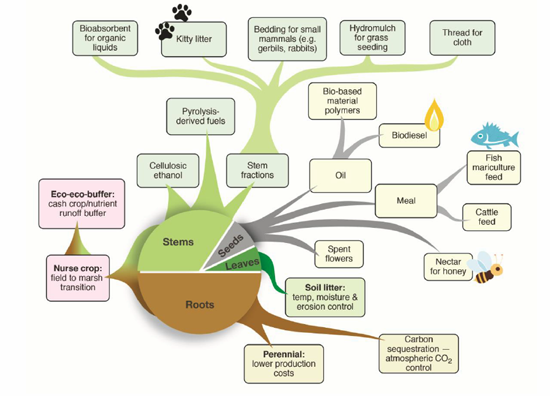
Fact Sheets And Publications
Adapting to Sea level Rise: Economic and Ecologic Roles for Seashore Mallow
Although seashore mallow has application in inland saline or non-saline situations these thoughts are particularly about problems driven by climate change and sea level rise and its impact on the coastal ecotone. As sea level rises, perhaps at a more rapid rate than earlier in our lives, low lying farm fields that are often very productive under dry land cultivation and their buffers will become salinized, as will rivers, and some aquifers. Non-salt-tolerant nutrient management buffers between housing and other development will be lost and perhaps replaced by invasive species. Recent storm tides provide such evidence in coastal farm fields where, unless a “nurse crop” is present to encourage the growth of desirable wetland plants, Phragmites often colonizes the vacated land and in woodland borders. These thoughts have led us to use the term, “self- subsidizing” and to look for multiple products and services that could be obtained from seashore mallow to subsidize the cost of making the biodiesel. In fact, these goods and services may exceed the EE value of the biofuel. The diagram below shows our latest array of products and services identified for seashore mallow. Some are well researched and some are not yet examined in depth.

The series of bullets below gives an idea of the depth of investigation of the products and ecosystem.
Mallow Products
- Oil – work in collaboration with Bryan Moser at Bio-Oils Research Unit at the National Center for Agricultural Utilization Research (NCAUR), USDA in Peoria. Mallow seeds from Delaware were used as a feed stock for the production of biodiesel and blends with petrodiesel were tested. Results were published in Renewable Energy 2012. Bryan says oil extraction and conversion can be easily integrated into soy processing.
- Cellulosic ethanol - Bruce Dien at NCAUR did this work and it is published in the same article as the biodiesel work. The outer part of thestem gave good yields, but the core yield was very low, hence he involved Stephen Vaughn in working on other uses of the stem.
- Stem fractions - Steve chopped the stems into pieces and separated them into size fractions. The finer fraction of the core was very effective as an absorbant for organic liquids and for kitty litter. Steve said mallow was the most absorbant material he has evaluated for that purpose. A manuscript by Steve and our group is available about this work and that about the bedding litter and hydromulch. The bedding had a slow compressibility and an unusual rebound quality when applied weight was removed. The outer bark has been made into thread for cloth by a group we collaborate with in China where we introduced mallow as a crop for newly “reclaimed “coastal soils. Those results are In press in Biomass and Bioenergy.
- Pyrolysis derived fuels- Rudy Behrens of the B.E.A.R. Group evaluated the straw of seashore mallow for this purpose.
- Bio-based polymers – The oil has been suggested as a candidate for polymer production by chemical engineers.
- Meal - Analysis of the meal by several groups indicates a good amino acid spread and possibility for use of mammals. It has been suggested that the use by cattle is limited to a fraction of the protein because of the residual oil left when it is crushed. However, a salmon aquaculturalist said the residual oil would not be a problem with his animals since their natural food is high in oil content.
- Honey -Nectar production is high and many bees and other insects are involved with pollination, however insects are not necessary since self pollination occurs readily.
- Spent flowers -Uses for the spent flowers are being explored.
- Roots-These are being considered for carbon sequestration for atmospheric CO2 to compensate for gases released by fuel produced. Roots are being investigated as a source of gums and other products for extraction when the perennial has reached a point where replanting is being considered.
Mallow Ecosystem Services
- Eco-eco-buffer – Used as a crop at the upper ecotonal edge seashore mallow absorbs nutrients moving either way across the boundary and harvesting seeds and stems cycles the nutrients away from the zone. Thus, they do not wash into the aquatic phase in flooding water or runoff either as particulate or dissolved components after decomposition.
- Nurse Crop – Graduate student, Nicole Voutsina, did her three year thesis study on this ecosystem engineering role of mallow. A manuscript on the topic is under review in Coasts and Estuaries.
CONTACT INFORMATION:
John L. Gallagher & Denise M. Seliskar – University of Delaware, Halophyte Biotechnology Center, 700 Pilottown Rd., Lewes, DE 19958 (jackg@udel.edu; seliskar@udel.edu; 302-645-4264; 302-645-4366)
UD Cooperative Extension
This institution is an equal opportunity provider.
In accordance with Federal law and U.S. Department of Agriculture policy, Cooperative Extension is prohibited from discriminating on the basis of race, color, national origin, sex, age, or disability.
